
In their effectiveness, mole traps are one of the best means of combating these animals on the site - they, unlike many types of repellers, work stably and allow you to get a very clear and tangible result. With the right approach, even home-made molehills allow you to quickly catch animals and not sacrifice comfort in the garden (you must admit that it’s not very pleasant to smell, for example, rotten fish stuffed in moleholes, or to constantly hear the sound of cans planted on metal pipes) .
At the same time, any trap for moles has its own specific and not always convenient features of use, as well as some disadvantages compared to repellents. For example:
- Traps are generally more difficult to install and use. If, for example, an electronic mole repeller is simple enough to install in the right place on the site and turn it on, then the trap needs to be dug properly in the place where the moles can get into it, and then the caught animals need to be taken out of the site and released (you’re not going to wait for them to die?);
- Do-it-yourself traps are harder to make than most folk repellents;
- And finally, even if you buy the most effective traps for moles, this without additional measures will not save the site from the periodic penetration of new animals on it. So, talking about the 100% efficiency of mole traps is also not necessary. However, not everything is so bad here - as practice shows, even getting rid of 10-15 moles, sometimes it is possible to create conditions for the fast withering of the entire population living in the nearby territory, as a result of which the “intrusions” will occur less and less, and then completely stop .

Well, if the mole repellers on your site do not give a result, then perhaps it is time to experience how effective the traps are.
It should be borne in mind that mole traps are different - they vary both in their effectiveness in different situations and in the principle of action and, in addition, in their humanity: some devices kill moles, and some catch alive. Let's see which option may be preferable in ordinary country conditions ...
Live traps or traps?
All means of catching moles can be divided into two types:
- Live traps that allow you to catch the animal without harming it;

- Lethal traps (traps, snares of various types, fishing hooks, etc.), either immediately killing the animal upon capture, or injuring it so badly that the probability of its subsequent survival is minimal.

The results of the use of these types of traps show that the efficiency of live traps is the same as the effectiveness of the means leading to the death of moles. The question of the use of this or that type of device in the end boils down only to whether the owner of the site is not too lazy to constantly take the captured animals out of the garden and let them out.
Based on humane considerations, traps and snares are significantly inferior to live traps, and if you can get rid of moles in the garden without killing animals, then it is better to choose a gentle option. Using devices that kill moles is little more than justifiable livelihood.
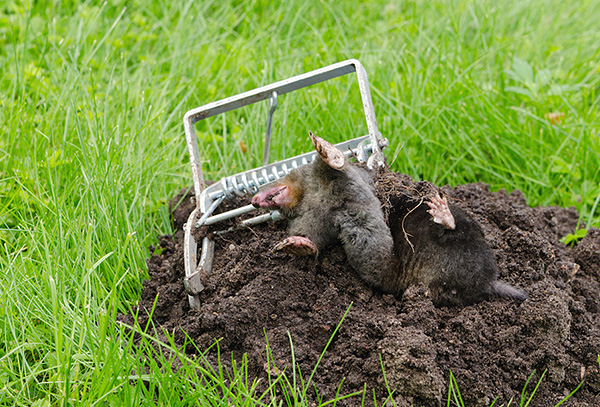
Further, the word "traps" will be understood primarily as live bait traps, in which the mole gets alive and unharmed. However, we will also consider various traps - in order to show what sadistic methods today individual summer residents are trying to fight with nature on their sites.
Pipe trap, purchased and homemade
Such a seemingly simple device, like a mole head pipe, in fact turns out to be very effective and convenient to use. The trap is a piece of plastic or metal pipe, the doors of which on both sides open only inward: the mole can enter the trap by simply pushing the door, but then can no longer exit it.
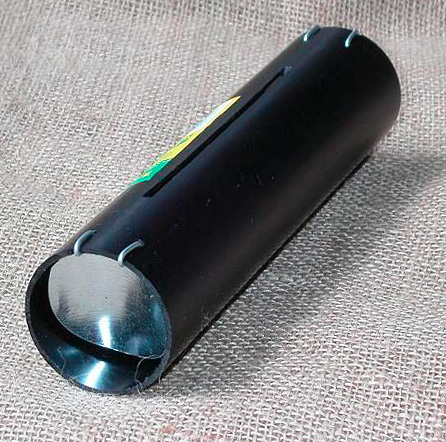
On a note
The mole head pipe also has an alternative name - the Solomon trap.
Due to its shape and size, with the correct installation of the mole-tube, the pipe, as it were, continues the underground course of the mole, integrating into it, and the animal penetrates the pipe, simply moving through its tunnel. Generally speaking, in order to capture a mole in this case, no baits are necessary, although some summer residents advise putting several chopped earthworms inside the trap - their smell is attractive to moles.

Krotolovka pipe can be bought in a store (including via the Internet), or made with your own hands. Homemade traps are made from plastic plumbing pipes, scraps of metal pipes, or from simple plastic bottles.
In the first case, the door is attached to the pipe, which opens upward and inward, which is not round, but slightly oval in shape, with its major axis located vertically so that the door is tilted with the bottom inward. In this case, the mole will be able to push it from the bottom only inward, and then it will not be able to get out of the pipe.

Practice shows that such traps can catch two moles at once in several hours, and in some cases even more, sometimes together with shrews, field voles and blind people:

Feedback:
“... Moles were digging, of course, actively, but I did not think there were so many of them. When I took the mole catcher, I felt sorry for the money. But when in one day I took out 6 (!) Moles on the field, and the next day I caught two more, I realized that I had not bought it in vain. It seems that here we have a whole hordes of them divorced, furrowing only on the road. Now I am enclosing the site with a foundation, but if there are still new heaps, then I am ready to fight back. ”
Valery, St. Petersburg
From plastic bottles traps for moles are made according to a slightly different principle. Here, the neck of another is inserted into the body of one bottle, and the neck itself should be cut with a knife or scissors into a kind of “petals”. The mole bends such petals almost without obstacles when passing into the trap, crawling into the main section. But he can’t get out again, since the plastic petals are closing, and the animal is not capable of bending them, despite his own.
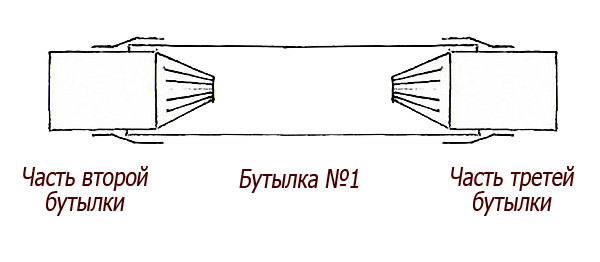
Regardless of its design, pipe traps are set in the mole moves between fresh heaps of land. Finding moves convenient for installing a trap is often quite easy: they are not far from the surface of the earth and their upper arches are slightly raised. The earth in this place looks like convex.
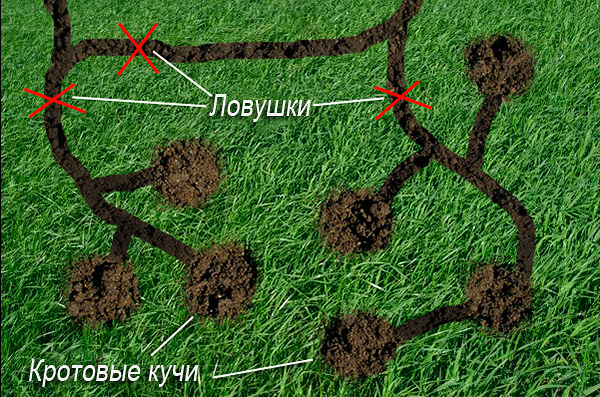
Such a move is unearthed, a trap is installed in it so that its bottom is almost at the same level with the bottom of the tunnel. Then, the excavated place is either covered with earth or covered with opaque material (for example, a plywood sheet).
On a note
No need to worry that the mole will be frightened by the door or “petals” at the entrance to the trap. In the course of the courses, the earth is constantly showered, and as it moves, the animal has to overcome various obstacles all the time. Compared to natural barriers, an easily opening door will not seem suspicious.
It is easy to buy a pipe trap for industrial production in specialized online stores, some of which provide quick courier delivery in Moscow and St. Petersburg, as well as deliver by mail to other regions. It is important to take into account that if a garden plot of land is large and moles “frolic” on it quite actively, then it may be appropriate to use not one, but two or more traps at once.
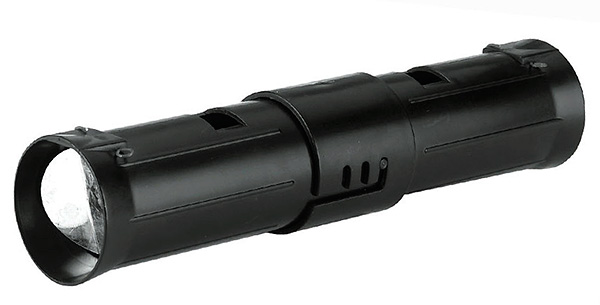
Feedback:
“... It’s easier, of course, to buy a ready-made one. Bought, set, caught. Everything, no hassle with manufacturing. But I still wanted to do it myself, I needed three traps for moles, there were already all the drawings. It seems that everything is simple - a piece of tin, a pipe, wire, nothing superfluous, but there is a lot of trouble until you collect and set everything up for sure. But in two days he did everything ... "
Alexander, Moscow
Pit trap and rules for its use
The principle of operation of the pit trap is that the mole, moving along its underground passage, falls into a specially prepared “pit” for it, into which a glass jar, bucket or pan is installed.
Making such a trap with your own hands is much easier than a mole catcher-pipe. By and large, any container of a suitable volume with a sufficiently wide neck is already a ready-made basis for a trap. Many gardeners have successfully used for this purpose even two-liter plastic bottles, but it is advisable to take a larger container - for example, the same bottle, but five-liter, or a bucket.

On a note
In the trap-pit, as well as in the mole-trap-pipe, any permanent or temporary visitors to mole passages, including harmful rodents, can fall. Shrews that are quite useful for the garden may fall here (although many gardeners unknowingly rank them as pests).
If a mole and a small rodent, or a lizard, fall into the pit at the same time, then it is highly likely that the mole will eat its “neighbor” so as not to starve to death.
So, to install such a trap on the path of the wormhole, a hole of the appropriate diameter and depth is dug up so that the bottom of the course is flush, or slightly above the upper edge of the tank lowered into the pit. In this case, it is desirable to damage the walls of the underground passage as little as possible, since significant damage can scare off the mole.
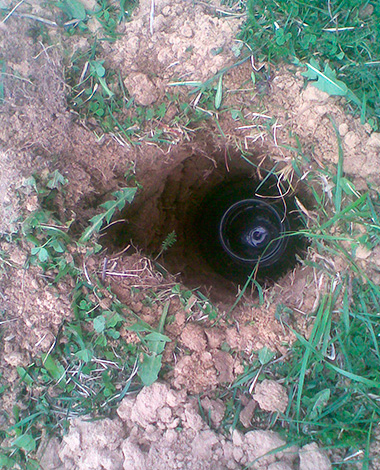
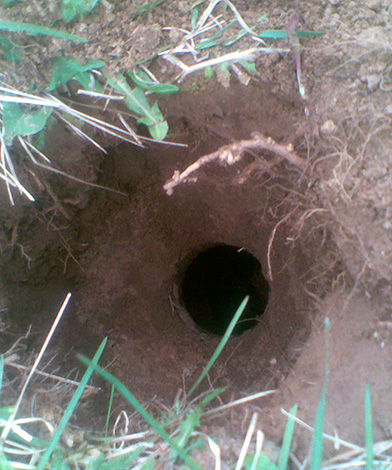
Then a suitable container is lowered into the pit, a roller from the ground is bent over its upper edge, and the entire excavated passage is covered from above with opaque material. When the mole once again checks its feeding course, it is likely to fall into the trap and not be able to get out of it.
On a note
Ideally, the depth of the pit trap should be at least 40 cm, since moles can sometimes overcome vertical obstacles up to 35 cm high.
The video below shows how to catch a mole in a jar:
What to do with a mole after capture?
Live traps should be checked every 3-4 hours. Since moles are very sensitive to hunger strikes, they need to be taken out of the traps as soon as possible - for more than 24 hours the mole is unable to live without food due to an accelerated metabolism. At the same time, it’s also not worth looking into the mole catcher every fifteen minutes, since such a fuss will only scare away the animal.
Immediately after the mole is caught, it is necessary to remove it from the trap: this must be done with tight gloves so that it does not bite through the skin. Then the animal must be taken outside the site at a distance of about 1-1.5 km - then the mole will no longer be able to return to its territory.

On a note
It is “accidental” to forget to take the mole out of the trap, after which the animal dies of hunger - it is even tougher that it is simple and quick to kill it, for example, with a trap. Still, starvation is far from the most pleasant thing, so to speak. And if you do not want to consider yourself a flayer, then you should not forget about these nuances.
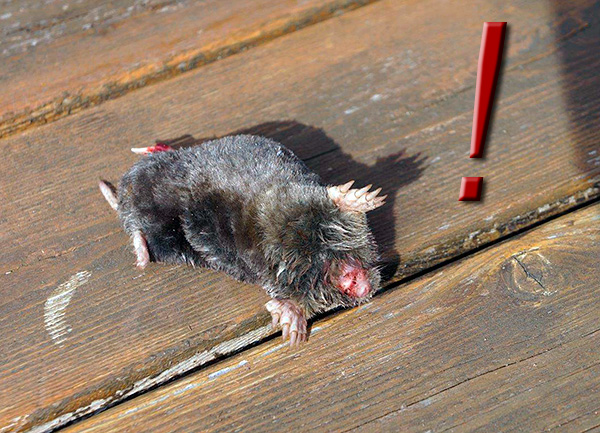
It is advisable to let out a mole in a dense bush or in dense grass, where predators cannot immediately catch it and where it will have sufficient chances to have time to dig into the ground.
Plunger traps, including Skat 61 and Skat 62
Skat 61 and Skat 62 plunger traps are designed to kill moles, and therefore, generally speaking, their use in a civilized economy is undesirable.
The principle of operation of these traps varies:
- In the trap for moles Skat 61, the principle of a crossbow is applied. Her legs are stuck into the ground on the sides of the mole's stroke, and the gatehouse after cocking the spring is introduced into the stroke itself. When the mole touches the gatehouse, the spring descends and three mobs pierce the mole.In many cases, death does not occur immediately, and the animal is tormented for several tens of minutes;

- In Skat 62, the principle of operation is similar, but after touching the gatehouse, the spring compresses the brackets that crush the animal (or part of it) between themselves.

The disadvantage of these traps lies not only in the inhumanity of their use, but also in the fact that after operation the device no longer works until it is released from the corpse and re-cocked. For comparison: as many moles are caught in the same mole catchers-pipes or pits as they can even fit into a trap.
That is, in spite of the fact that Skat 61 and Skat 62 are positioned as professional plunger traps from moles, they are noticeably inferior to live traps in the efficiency of their work.
Trap loop and its design options
The traps in the form of loops are implemented in several versions. The most common is the wire loop shown in the photo:


It is laid in the course of the animal, and after triggering it either strangles the animal, or simply squeezes its body, which leads to death after a certain time. Some gardeners make such wire traps with their own hands according to ready-made drawings.
The loopback traps of the following designs work similarly:
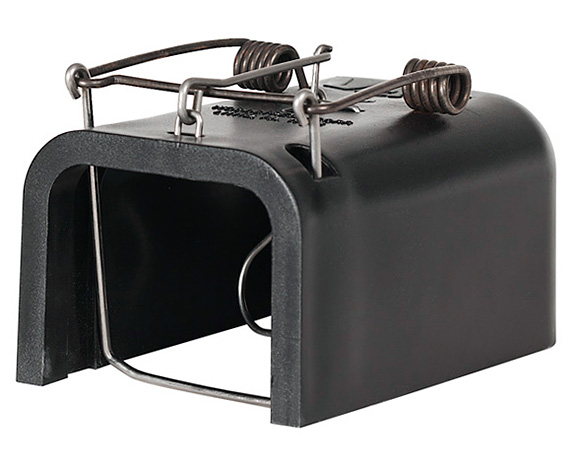
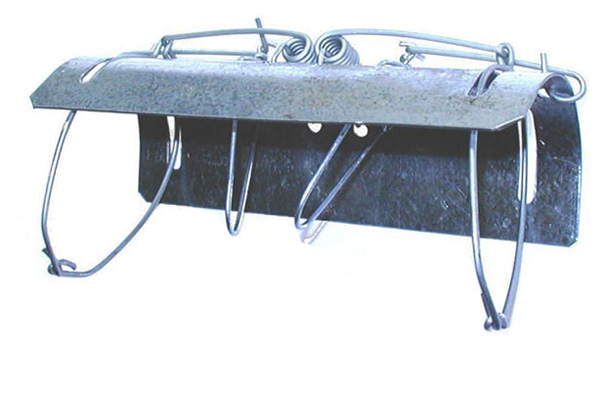
Crush traps
Also, standard mole traps are sometimes used against moles. If the mouse for pulling the mechanism pulls the bait on the gatehouse, then the mole simply crawls on the gatehouse and with its body lowers it.
The photo below shows a typical wooden mousetrap:
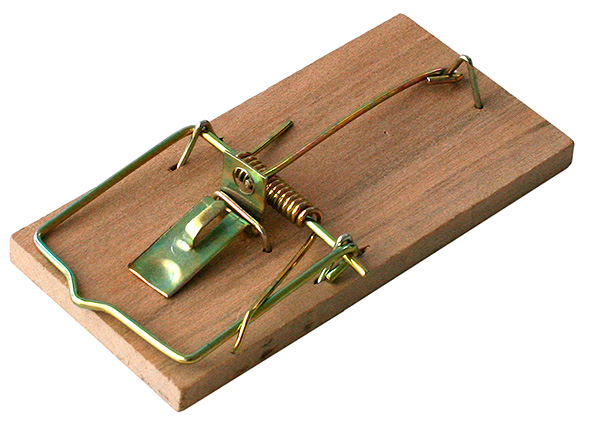
Feedback
“I wanted to somehow buy a trap for moles in Kursk. Do not believe it, I did not find it on sale. I decided to try a simple mousetrap. Somehow I got a drum, the mole will be tormented there, or not, the main thing is not to harm it. I unearthed one move and set the trap simply, without bait. The next day I checked - it was wound up, another day later - the same thing. The mole began to dig elsewhere. Put the trap in a fresh move, the same result. I chased this cunning creature for a week, I tested three points, but there is no result. Let's see what the vaunted pipe shows ... "
Vyacheslav, Kurchatov
In the case of a competent approach, the efficiency and ease of use of traps practically do not differ from livestock traps, however, the use of such lethal means to destroy moles can be considered as to some extent senseless cruelty.
Swissinno Mole Trap Trap
The Swiss miracle of technology, the Mole Trap SuperCat mole trap is a cross between a Skat 61 plunger trap and a mousetrap crush. The principle of operation of the design is quite simple - the product is inserted across the mole, the spring is cocked, opening the entrance to the beast and leading the gatehouse. As soon as the mole comes across the gatehouse, the spring descends and crushes the head or neck of the animal.

A probe for reconnaissance of the course and a special device for quickly preparing the pit for the trap itself are supplied with the trap. It looks like the one shown in the video below:
On a note
Swissinno’s previous Mole Trap model of mice and moles worked on the same principle as Scat 62 - it crushed the animal with two brackets that closed like scissors.

In general, the Mole Trap trap is fairly easy to use, but expensive. The price of the old version is about 2000 rubles (which is two times more expensive than the analogue of Skat 62), and the new one is about 3500 rubles.
Self-arrows
There is also a very complicated and dangerous method of destroying moles with self-arrows. Let us consider it as an example of what people are not going to, trying by any means to destroy the underground inhabitants on their site.
So, how does the crossbow work: in the course of the animal, a pipe sealed on one side is installed, into which the powder is poured and the shot is charged.A nichrome wire is fed to the powder through a thin hole, and a motion sensor connected to it is installed at 20-30 cm along the hole. When the mole passes under the sensor, it turns on the battery, it glows the wire and after a fraction of a second the self-gun fires.
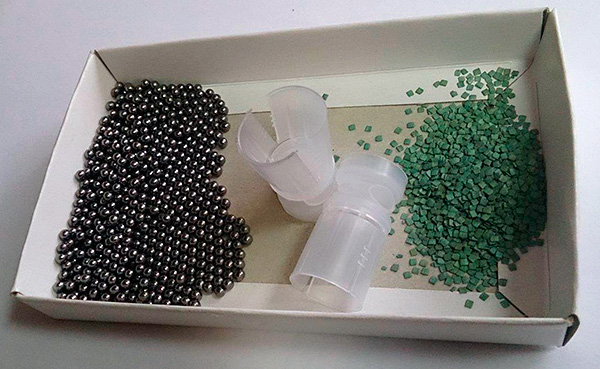
It is clear that the mole then dies. It is also quite obvious that the device of such a self-shoot is many times more complicated than the use of any other home-made traps. Perhaps, the use of self-arrows is today more for the enthusiastic flayer who agree to spend their time and energy on the invention of increasingly sophisticated methods of killing animals.
Catching moles with fishing hooks
And another barbaric way of catching moles, which is not, in fact, a trap, but allows you to catch and mutilate the animal: a fishing line with fishing hooks (usually triple) is lowered into the course, the end of which is pulled out and attached to a pin stuck into the ground or simply to a lying one on the ground stick. The mole, moving along the course, runs into hooks that cling to his body and pierce the skin, starts to jerk the fishing line, trying to free itself. These jerks are visible by moving the fishing line and the pin, and if you hang a bell on the pin itself, it will still ring at the same time.

When the animal comes across, it is simply pulled out of the hole by the fishing line (who cares if the hooks go deeper into the body even more, or even tear the skin and muscles).

It is clear that you can only remove the hook from the body of the mole by tearing muscle fibers, or even with a piece of meat. However, people who prefer to catch animals in this way do not really think about how to act more carefully with the animal, and in the best case they will not scoff at it before the murder ...
On a note
Even the advice of seasoned “sadistic gardeners” is known - say, worms can be put on hooks so that the mole, eating the bait, clings to the hook with its mouth like a fish. One can only hope that most summer residents still realize that fishing hooks are not the method that should be used to fight moles in the area.
As a result, we can conclude that for a successful, effective and fairly quick capture of moles, it is quite enough to use mole traps in the form of a pipe or pit. Their effectiveness is about the same as that of traps (and sometimes higher), and with their help you can get rid of pests without killing, in general, innocent animals.
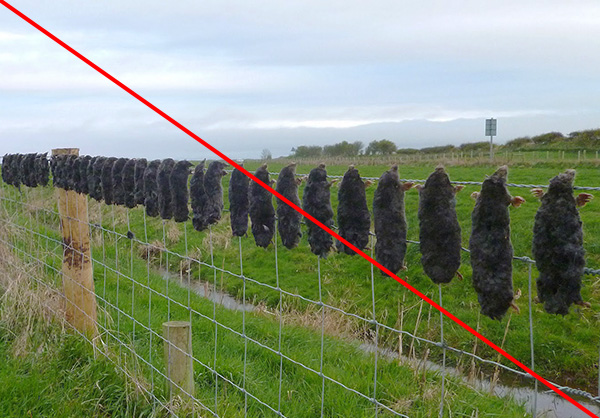
It is also important to keep in mind that removing moles from a site once does not mean forgetting about them forever. If once they entered the garden, they can do this in the future. To exclude the possibility of the re-emergence of moles, the site should ideally be fenced around the entire perimeter with a grid or other fence dug in the ground. This will help prevent future conflicts between the gardener and the mole.
If you have your own experience in fighting moles with a trap of any type, be sure to leave your review at the bottom of this page - maybe it will help someone draw useful conclusions.
Useful video: catching a mole in a pipe trap
Several proven methods of fighting moles in the area


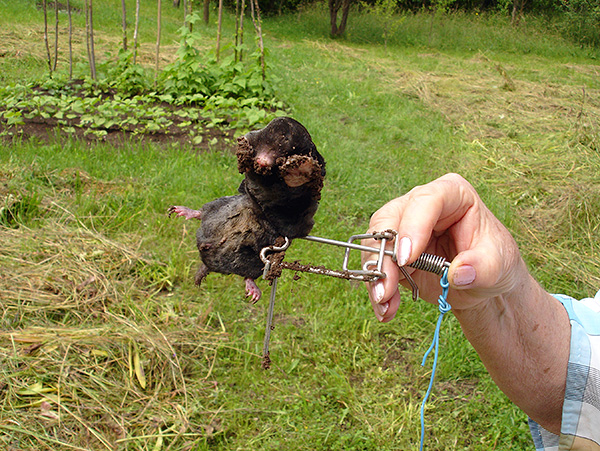




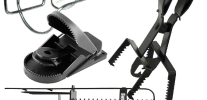
Thanks for the extended info! Caught only traps. Let's try your traps.
Yes, the information is useful, but I’m not at all sorry for these reptiles, although until today I had no desire to kill any of the mice, rats or moles. However, today I am ready to stand with a gun or a shovel near the mole’s hole and kill him without blinking an eye. Moles have already destroyed several apple trees, walnut trees, 2 pines and pomegranate bushes in our area, undermining their roots. And how hard it was for us to grow it in a hot desert on stone ground! Today, another pine had to be transplanted urgently into a pot, because she no longer has roots. I'm just howling in my voice! We have not yet caught a single reptile in the known gentle methods, and I declared war on them. It is very difficult for us, retirees of 65 and 75 years, to look after a grown garden, and these bastards nullify our work. Moles have already crept up to the apricot trees. So let the defenders of these beasts themselves experience this hard labor of growing trees and ridding the site of uninvited guests.
Moles physically could not do this - the roots, especially trees, and the fruits they do not gnaw, because they simply do not have physiological devices for this. They feed on worms and bugs. Turn on the brain and look for diseases and problems in the soil.
The roots of the trees gnaw rats. And they walk along the paths laid by the moles. If there are no moles on the site, then there will be no all kinds of rodents, and the garden will not perish. And so, yes - paths to rodents are laid by moles.
Thank. Useful article, I will try the recommended methods and traps.
Hello. Please share your experience of catching moles. While applying pipes of 75 and 65 mm wide, to no avail. A few rats. A mole clogs the pipe with earth, but does not climb into the middle. I would be grateful for a few words.